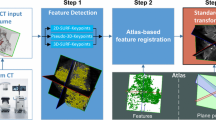Abstract
Purpose
The main challenge of intramedullary nail (IM-nail) fixation surgery is to achieve the X-ray shot in which the distal holes of the IM-nail appear as circles (desired view); screw insertion is then performed. Although C-arm X-ray devices are routinely used in IM-nail fixation procedures, the surgeons or radiation technologists (rad-techs) usually utilize them in a trial-and-error manner. This increases both radiation exposure and surgery time. This study addresses the problem by presenting a C-arm-based IM-nail pose recognition method.
Methods
The specific purpose of this study was to develop and validate an automated technique for identifying the current pose of the IM-nail relative to the C-arm. An accuracy assessment is performed to test the reliability of the navigation results. The algorithm starts with a sequential biplanar set of X-ray imagery (acquired from a tracked C-arm) of the distal part of an inserted IM-nail. The image-processing module then extracts features of interest, and a mathematical model incorporates them to calculate the six degree-of-freedom position and orientation parameters of the nail.
Results
Translational accuracy was demonstrated to be better than 0.5 mm, rotational accuracy for roll and pitch to be better than \(2^{\circ }\) and for yaw to be better than \(2.5^{\circ }\) depending on the separation angle. Computation time was less than 0.5 s.
Conclusion
An IM-nail distal locking navigation technique is introduced in this study that leads to more accurate and faster screw placement with a lower consumption of radiation dose and a minimum number of added steps to the operation.













Similar content being viewed by others
References
Neatpisarnvanit C, Suthakorn J (2006) Intramedullary nail distal hole axis estimation using blob analysis and Hough transform. In: IEEE conference on robotics, automation and mechatronics. doi:10.1109/RAMECH.2006.252685
Muller LP, Suffner J, Wenda K, Mohr W, Rommens PM (1998) Radiation exposure to the hands and the thyroid of the surgeon during intramedullary nailing. Injury 29:461–468
Krettek C, Mannss J, Miclau T, Schandelmaier P, Linnemann I, Tscherne H (1998) Deformation of femoral nails with intramedullary insertion. J Bone Joint Surg 16:572–575. doi:10.1002/jor.1100160508
Krettek C, Könemann B, Miclau T, Schandelmaier P, Blauth M, Tscherne H (1997) A new technique for the distal locking of solid AO unreamed tibial nails. J Orthop Trauma 11:446–451
Abdlslam KM, Bonnaire F (2003) Experimental model for a new distal locking aiming device for solid intramedullary tibia nails. Injury 34:363–6
Zhu Y, Phillips R, Griffiths JG, Viant W, Mohsen A, Bielby M (2001) Recovery of distal hole axis in intramedullary nail trajectory planning. In: International conference on robotics and automation, pp 1561–1566
Viant WJ, Phillips R, Griffiths JG, Ozanian TO, Mohsen AM, Cain TJ, Karpinski MR, Sherman KP (1997) A computer assisted orthopaedic surgical system for distal locking of intramedullary nails. J Eng Med 211:293–300. doi:10.1243/0954411971534412
Suhm N, Jacob AL, Nolte LP, Regazzoni P, Messmer P (2000) Surgical navigation based on fluoroscopy-clinical application for computer-assisted distal locking of intramedullary implants. Comput Aided Surg 5:391–400. doi:10.1002/igs.1001
Leloup T, El Kazzi W, Schuind F, Warzée N (2008) A novel technique for distal locking of intramedullary nail based on two non-constrained fluoroscopic images and navigation. IEEE Trans Med Imaging 27:1202–1212. doi:10.1109/TMI.2008.920602
Zheng G, Zhang X, Haschtmann D, Gedet P, Dong X, Nolte LP (2008) A robust and accurate two-stage approach for automatic recovery of distal locking holes in computer-assisted intramedullary nailing of femoral shaft fractures. IEEE Trans Med Imaging 27:171–187. doi:10.1109/TMI.2007.904692
Chan DS, Burris RB, Erdogan M, Sagi HC (2013) The insertion of intramedullary nail locking screws without fluoroscopy: a faster and safer technique. J Orthop Trauma 27:363–366. doi:10.1097/BOT.0b013e3182828e10
Knudsen CJM, Grobler GP, Close REW (1991) Inserting the distal screws in a locked femoral nail. J Bone Joint Surg 73–b:660–661
Harstall R, Heini PF, Mini RL, Orler R (2005) Radiation exposure to the surgeon during fluoroscopically assisted percutaneous vertebroplasty. Spine 30:1893–1898
Amiri S, Wilson DR, Masri BA, Anglin C (2013) A low-cost tracked C-arm (TC-arm) upgrade system for versatile quantitative intraoperative imaging. Int J Comput Assist Radiol Surg 9:695–711. doi:10.1007/s11548-013-0957-9
Hough PVC, Arbor A (1962) Method and means for recognizing complex patterns. Haugh PVC, Arbor A, Assignee. Patent US3069654 A. 25 Mar 1960
Duda RO, Hart PE (1972) Use of the Hough transformation to detect lines and curves in pictures. Commun ACM 15:11–15. doi:10.1145/361237.361242
Horn BKP (1987) Closed-form solution of absolute orientation using unit quaternions. J Opt Soc Am 4:629–642
Acker S, Li R, Murray H, John PS, Banks S, Mu S, Wyss U, Deluzio K (2011) Accuracy of single-plane fluoroscopy in determining relative position and orientation of total knee replacement components. J Biomech 44:784–7. doi:10.1016/j.jbiomech.2010.10.033
Mahfouz MR, Hoff WA, Komistek RD, Dennis DA (2003) A robust method for registration of three-dimensional knee implant models to two-dimensional fluoroscopy images. IEEE Trans Med Imaging 22:1561–1574. doi:10.1109/TMI.2003.820027
Acknowledgments
The authors wish to thank Alberta Innovates Technology Futures (AITF), the Natural Sciences and Engineering Research Council of Canada (NSERC) and Canadian Institutes of Health Research (CIHR) for funding.
Author information
Authors and Affiliations
Corresponding author
Ethics declarations
Conflict of interest
Hooman Esfandiari, Shahram Amiri, Derek Lichti and Carolyn Anglin declare that they have no conflict of interest.
Rights and permissions
About this article
Cite this article
Esfandiari, H., Amiri, S., Lichti, D.D. et al. A fast, accurate and closed-form method for pose recognition of an intramedullary nail using a tracked C-arm. Int J CARS 11, 621–633 (2016). https://doi.org/10.1007/s11548-015-1294-y
Received:
Accepted:
Published:
Issue Date:
DOI: https://doi.org/10.1007/s11548-015-1294-y




